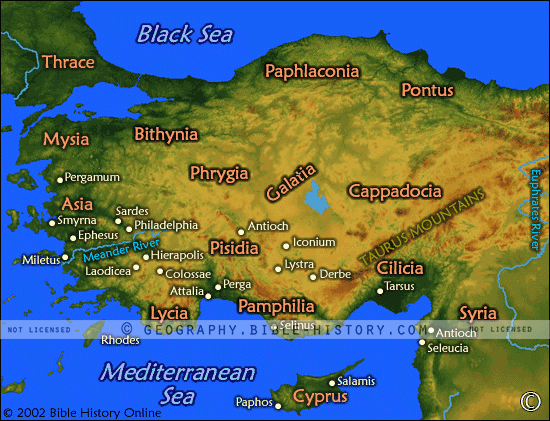
The map of the Cities of the New Testament 3 takes you on a comprehensive visual journey through additional urban landscapes that played a significant role in the events and teachings of the New Testament. These cities served as hubs of early Christian activity, spreading the message of Jesus and laying the foundation for the growth of Christianity. Here is a description of this historical map:
Expanded Geographical Scope:
This map further extends the geographical scope, encompassing even more locations mentioned in the New Testament. It provides a broader view of cities and regions across the eastern Mediterranean, including modern-day Turkey, Greece, Cyprus, and beyond.
Key Cities and Landmarks:
The map prominently features additional cities and landmarks that are closely associated with the apostolic journeys, missionary activities, and the growth of early Christian communities. It includes places like Antioch, Troas, Pergamum, Patmos, and Crete, among others.
Religious Significance:
This map continues to emphasize the religious significance of these cities in the Christian tradition. It highlights the places where significant events, missionary endeavors, and the writing of New Testament texts took place.
Historical Context:
The map provides historical context for these New Testament cities, shedding light on their political, social, and cultural environments during the time of the Roman Empire. It explores the diverse populations and religious beliefs that characterized these urban centers.
Missionary Routes and Journeys:
It outlines the missionary routes and journeys of key figures in early Christianity, including the apostle Paul and other prominent figures, as they traveled to these cities to spread the teachings of Christ.
Cultural Insights:
Exploring the map allows viewers to gain insights into the culture, society, and daily life of the people living in these New Testament cities. It offers a connection to the customs, traditions, and challenges faced by the early Christian communities in these diverse locales.
Religious Communities and Sites:
The map may also indicate the locations of early Christian congregations, places of worship, and significant sites where biblical events and teachings unfolded.
Archaeological Discoveries:
Incorporating markers or references to archaeological discoveries and excavations in these cities can provide tangible evidence of the historical accuracy of New Testament accounts and the enduring legacy of early Christianity.
The map of the Cities of the New Testament 3 expands the exploration of the urban tapestry of the New Testament narrative. It allows viewers to delve even deeper into the geography, history, and cultural context of these iconic cities, further enriching their understanding of the events, teachings, and early Christian communities that shaped the New Testament story.